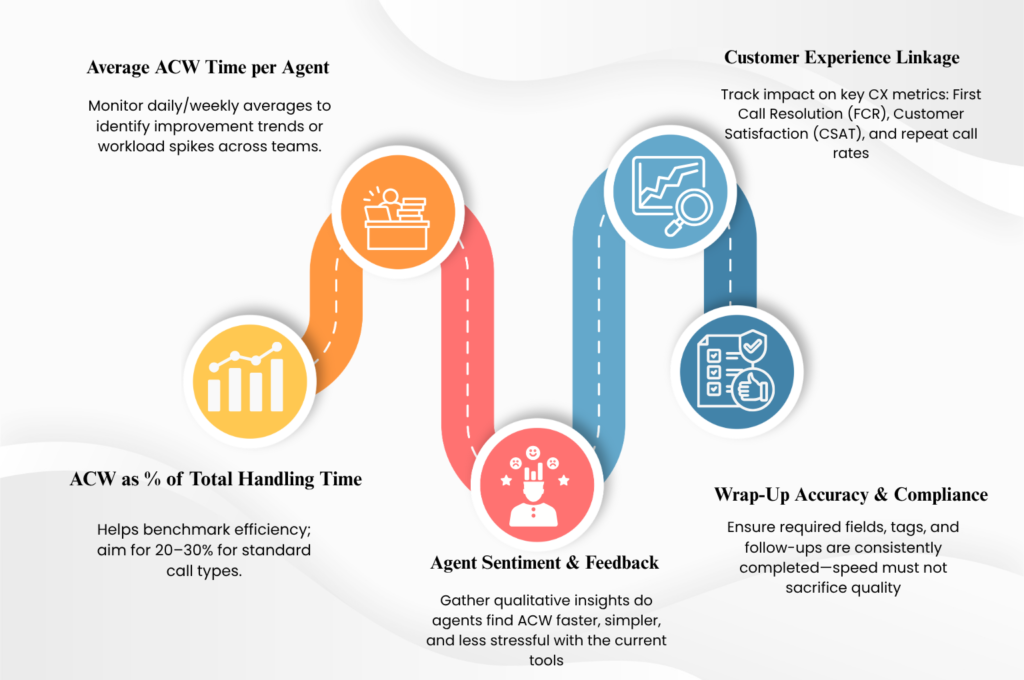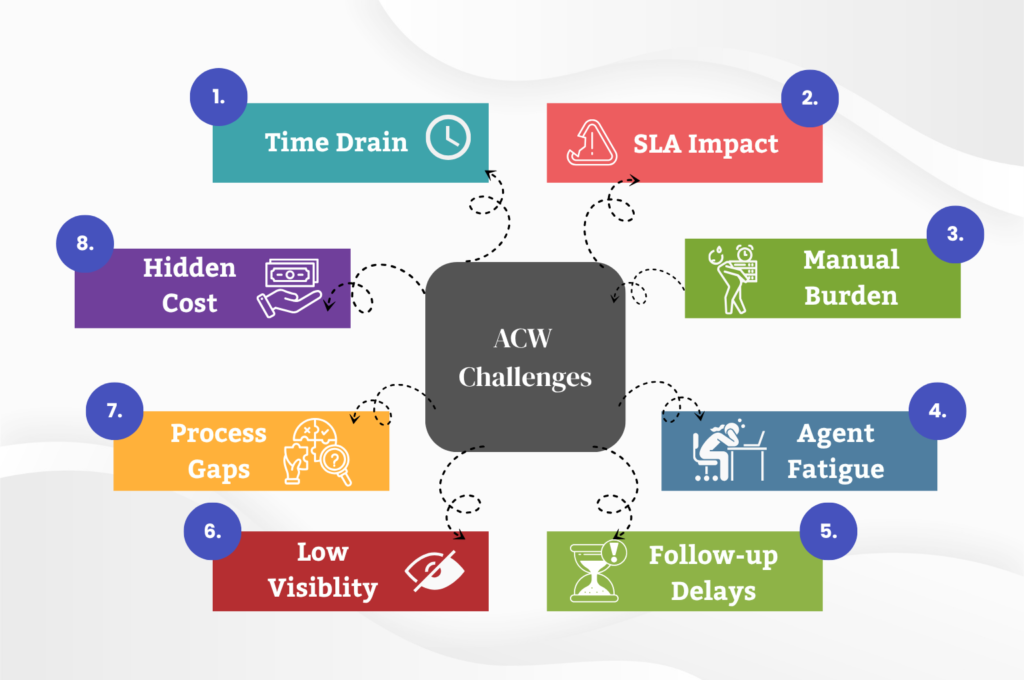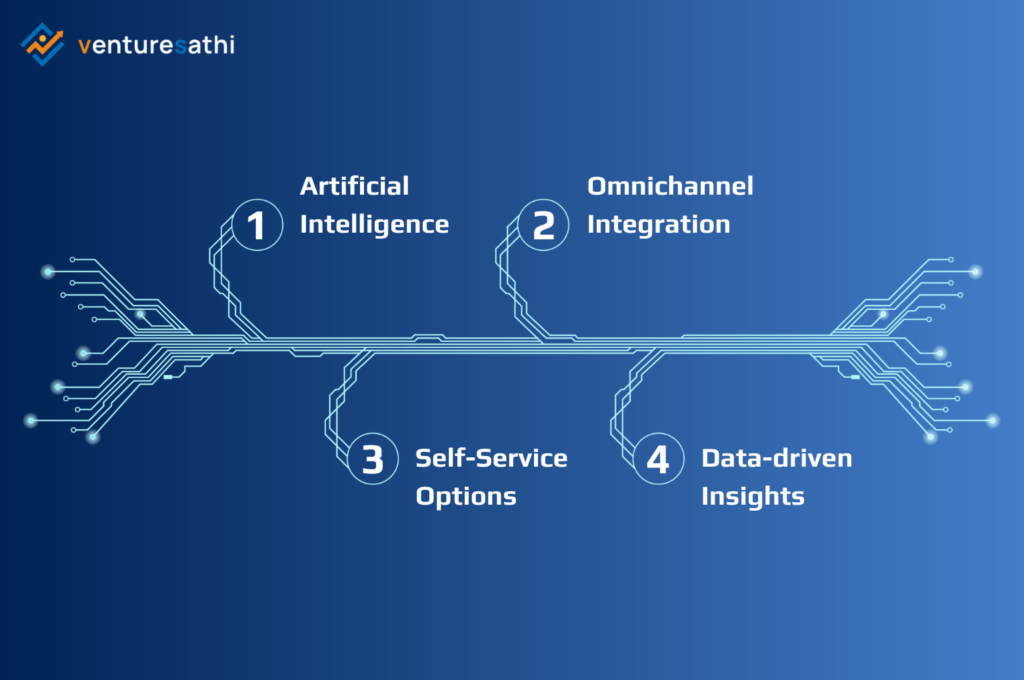
- What Exactly Is ACW and Why It’s More Than Just Admin
- The Cost of Unmanaged ACW: Why Metrics Matter
- Industry Standards: What’s an Ideal ACW Time?
- How High-Performing Contact Centers Tame ACW
- How to Measure the Impact of ACW: Metrics That Matter
- Process Redesign & Smart Workflow Mapping: The Unsung Hero of ACW Efficiency
- Conclusion: Rethink ACW as an Asset, not a Burden
You’ve hung up the call, but the work isn’t over yet. For every minute an agent spends talking to a customer, they may spend just as much if not more handling what comes after. Welcome to the world of After Call Work (ACW), a silent productivity killer when left unmanaged and a powerful optimization lever when done right.
As contact centers move toward performance-led models, reducing ACW has become a strategic priority. This blog explores what ACW is, why it matters, and how smart contact centers are turning this behind-the-scenes effort into a measurable efficiency gain.
What Exactly Is ACW and Why It’s More Than Just Admin
Imagine an agent wrapping up a call: they’ve provided help, solved a problem, or escalated an issue. But their day isn’t over their screen prompts them to fill out case fields, tag the call type, update contact records, send a confirmation email, or set a follow-up reminder. These tasks, often essential, are what we call ACW. They complete the interaction, but they also steal time the agent could have spent on new calls or proactive customer engagement. In theory, thorough ACW supports accountability and handoffs. When poorly designed or manual, it acts like hidden-ground traffic slowing the whole operation, inflating AHT, and even impacting morale as agents slog through repetitive admin tasks.
The Cost of Unmanaged ACW: Why Metrics Matter
After Call Work may seem like a back-end activity, but its impact on productivity, agent bandwidth, and customer experience is anything but invisible.
Let’s break it down: If an agent spends just 45 extra seconds per call on ACW and handles 50 calls per day, that’s nearly 38 minutes lost daily per agent. Across a team of 300 agents, this adds up to over 4,600 agent-hours per month purely on inefficient post-call tasks.
Why it matters:
Studies show agents typically spend 70% of their time on live calls. That leaves 30% for wrap-ups, documentation, and breaks. But when ACW becomes bloated, active handling time drops to 60% or less, tightening capacity and increasing burnout.
It doesn’t just affect productivity it hits KPIs hard. One of the most critical metrics impacted is Average Handle Time (AHT). With industry averages hovering around 6 minutes and 10 seconds per call, even shaving off 15–30 seconds in wrap-up can significantly boost call volume capacity without increasing headcount.
Industry Standards: What’s an Ideal ACW Time?
There’s no perfect number, but benchmarks do exist.
- Ideal Range: Most modern contact centers aim for 30 to 90 seconds of ACW. However, 20–30 seconds is the target range for highly efficient teams.
- High-Complexity Environments: Industries such as healthcare, legal, or finance (where compliance documentation is critical) may naturally require 3 to 10 minutes of wrap time per call.
- The goal isn’t to go fast at any cost : Instead, it’s to reduce friction, remove redundancy, and make wrap-up seamless. A shorter ACW with incomplete or inaccurate data hurts more than it helps.
Why ACW Slips Under the Radar
Several factors contribute to excessive ACW:
- Multi-Window Interfaces: Agents flip between CRM, chat logs, knowledge bases.
- Manual Data Entry: Re-typing call notes, tagging, and updating records.
- Inconsistent Documentation: Without guidelines, agents spend extra time crafting notes.
- Poor Training: Many agents lack structured ACW coaching.
- Lack of Automation: Missed opportunities to auto-send email confirmations or case tags.
Each of these snarls the post-call process and drags productivity
How High-Performing Contact Centers Tame ACW
- Smart UI and One-Screen Wraps
Fewer clicks mean faster wrap time. Agents benefit when systems bundle post-call actions in a unified interface. For example, a single wrap-up pane that lets agents select issue categories, send templated emails, and click “complete” cuts task switching and boosts accuracy.
- Template-Driven Data Capture
Pre-built forms with mandatory fields such as issue type, resolution, follow-up date speed up entry and improve data consistency, reducing manual effort.
- AI-Assisted Summaries and Tags
Real-time speech analytics can suggest call summaries or relevancy tags based on transcripts. According to industry reports, 63% of consumers appreciate personalized experiences. With AI, agents get contextual suggestions mid-session accelerating wrap-up and improving insight quality.
- Automated Follow-Ups
Features like auto-generated emails or ticket routing not only save time but also ensure accuracy and consistency. When an agent hits “end call,” the system immediately sends the appropriate response or escalation.
- Visible Wrap-Time Metrics and Coaching
Showing agents their own average wrap times in real-time encourages performance. Coupled with coaching, this helps reduce habit-based delays and supports peer learning.

How to Measure the Impact of ACW: Metrics That Matter
Reducing ACW isn’t just about shaving seconds it’s about building a smarter, more agile contact centers. To ensure your efforts are driving real value, you need to monitor the right metrics.
Here’s what high-performing team’s track:
- Average ACW Time per Agent: Track changes over time and across teams. Are improvements consistent? Are certain shifts or queues seeing spikes?
- ACW as a % of Total Handling Time: This helps you understand efficiency in context. For routine calls, ACW should ideally sit below 20–30% of total handling time.
- Wrap-Up Accuracy and Compliance: Are agents consistently completing required tags, case notes, and follow-ups? Speed means little without precision.
- CX-Linked Outcomes: Measure the ripple effect. Has First Call Resolution (FCR) improved? Are repeat calls dropping? Is Customer Satisfaction (CSAT) rising as agents spend more time engaging and less time typing?
- Agent Sentiment and Feedback: Sometimes, the clearest signal comes from your team. Ask agents: Is the wrap process faster? Is it less frustrating? Are the tools helping?
With an integrated performance dashboard offering real-time data, leaders can identify trends, spot coaching opportunities, and tie ACW directly to business outcomes.
Process Redesign & Smart Workflow Mapping: The Unsung Hero of ACW Efficiency
While AI garners headlines, many contact centers overlook the foundational power of process simplification. Sometimes, it’s not about automation it’s about asking: Why is this step even here?
Here’s how workflow redesign plays a critical role in reducing ACW:
- Eliminate Redundancy :-
Multiple data entries across different systems? Repeated steps in the wrap process? Identify and eliminate duplicate tasks that do nothing but slow your agents down.
- Streamline Templates and Forms :-
Simplify after-call templates. Pre-fill data where possible. Use dropdowns, checkboxes, and dynamic fields instead of long open-text sections. Even small UX changes can shave off precious seconds.
- Introduce Tiered ACW Based on Call Type :-
Not every interaction requires the same depth of wrap-up. Use intelligent routing logic that triggers different ACW workflows depending on call complexity basic queries need basic forms.
- Empower Agents Through Knowledge-Driven Wrap-Ups :-
Integrate your KMS (Knowledge Management System) within the ACW interface so agents can insert approved content or resolutions quickly. This reduces errors and ensures consistency in case documentation.
- Use Data to Re-Engineer Inefficiencies :-
Analyse bottlenecks. If agents spend most ACW time just searching for case IDs or tags, your system not your team is the problem. Map the agent journey and redesign for flow, not friction.

Conclusion: Rethink ACW as an Asset, not a Burden
After Call Work may feel like a back-room admin task, but it directly influences agent productivity, operational costs, and customer satisfaction. Even small reductions can yield major ROI: shaving 15–30 seconds off ACW could free up enough capacity for dozens more calls per week per agent. By embracing AI-powered scripts, integrated systems, and performance coaching, contact centers can redefine ACW not as a mundane necessity, but as a strategic advantage.
So, before you aim for lower AHT or higher service levels, look at what’s happening after calls. With intentional design, ACW can transform from a silent time-sink into a competitive differentiator.


